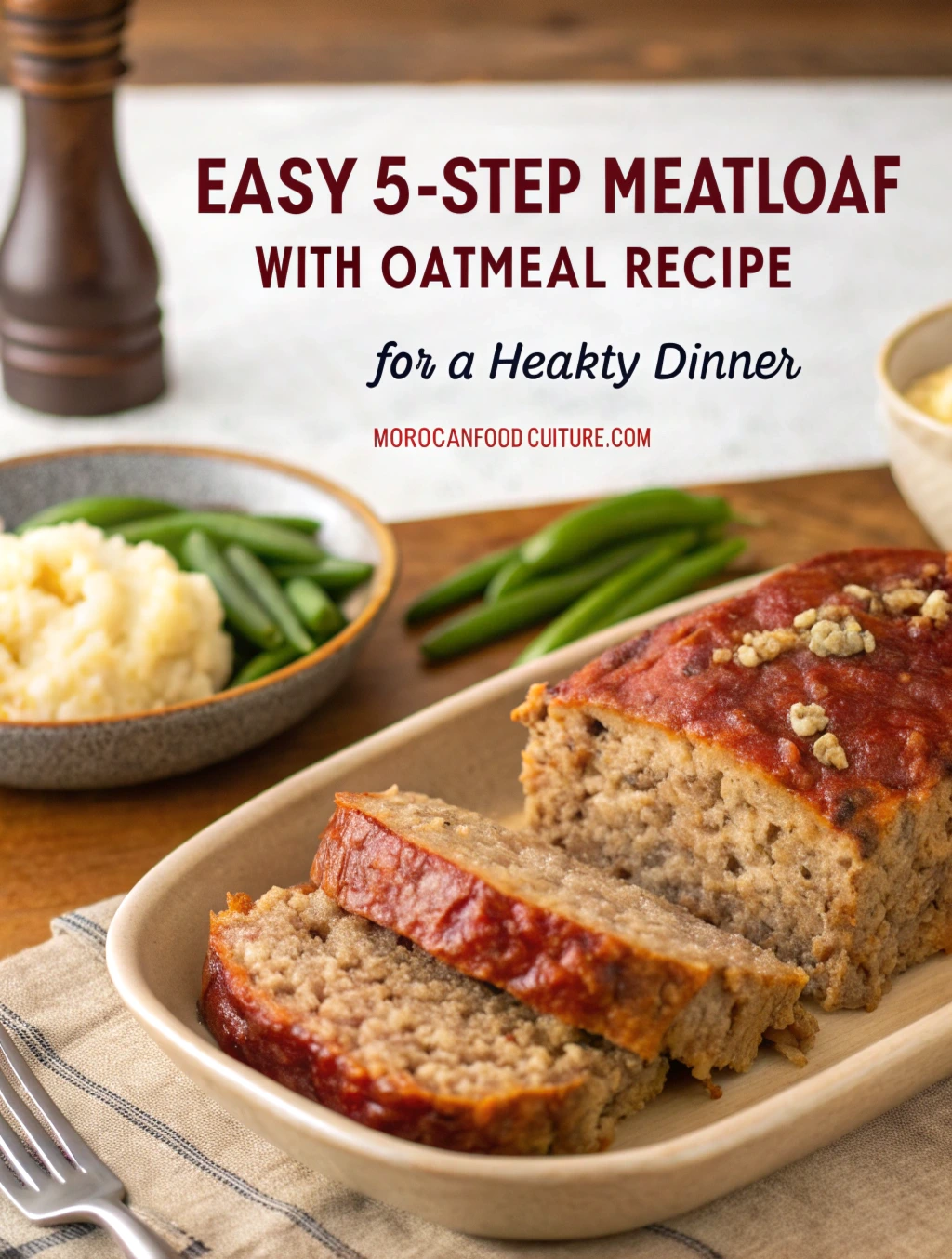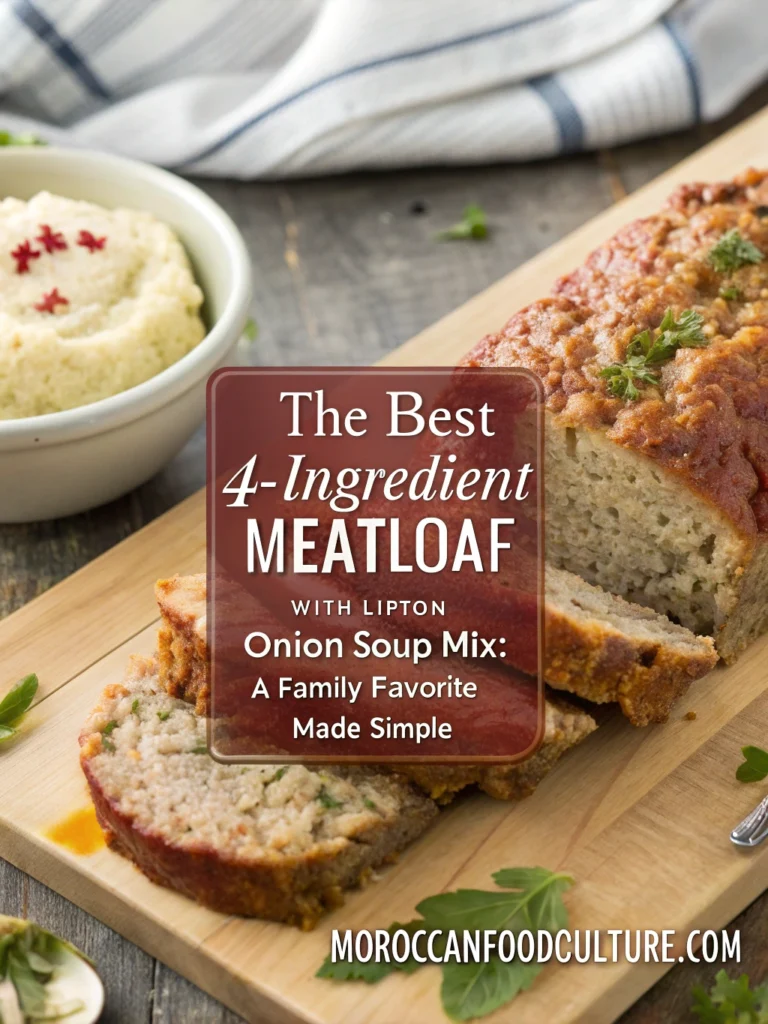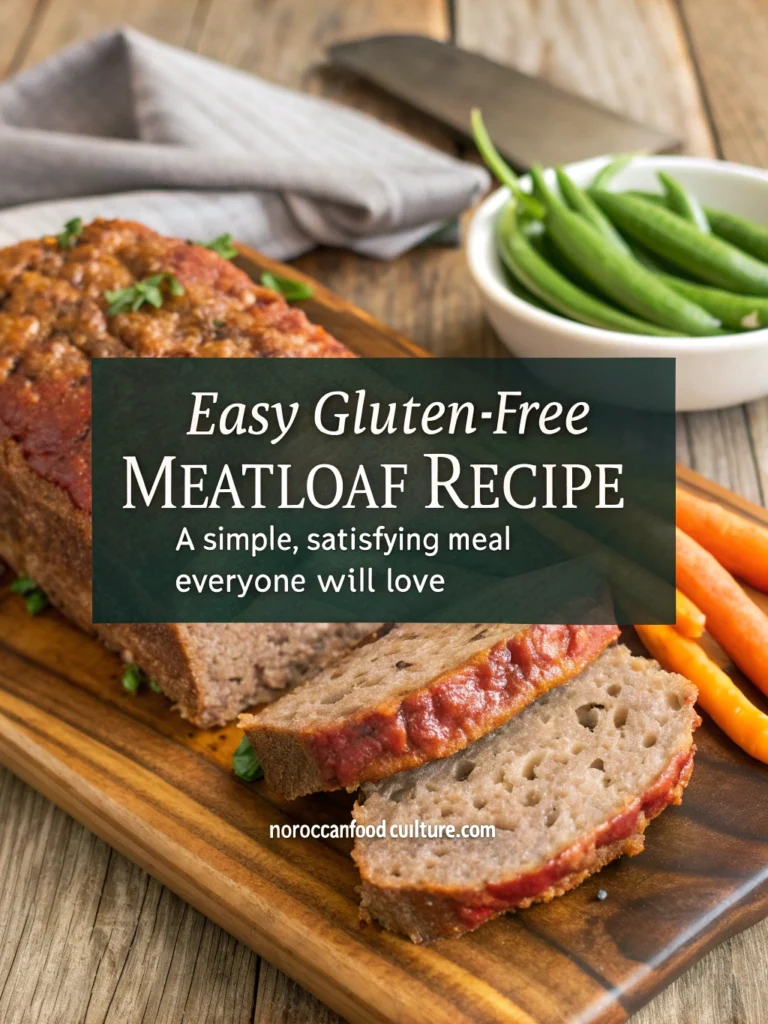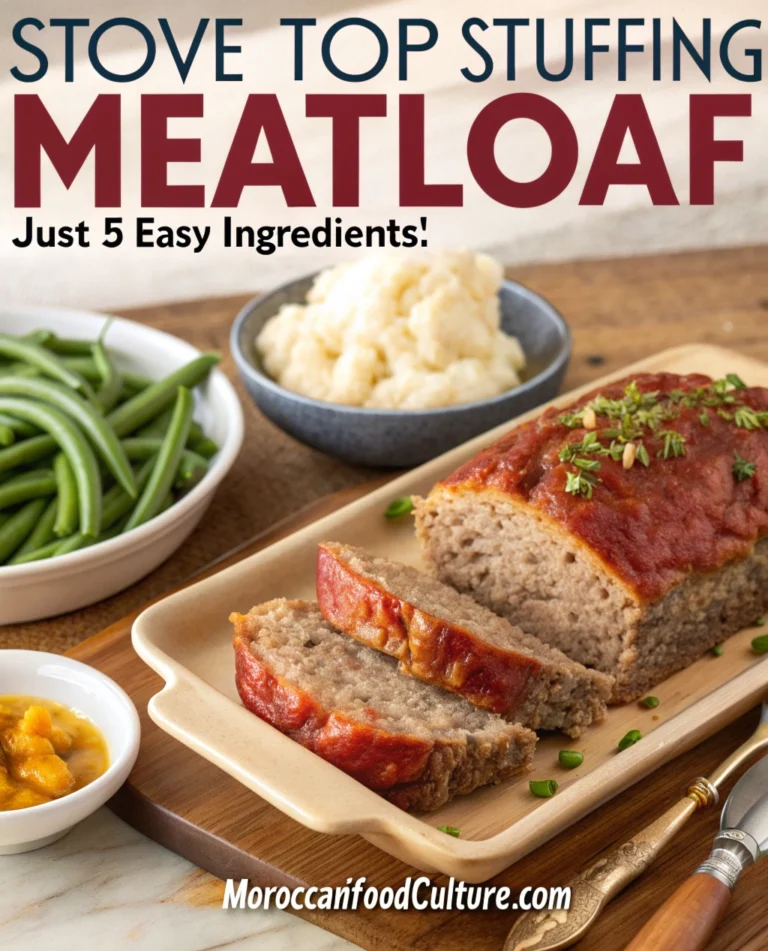The Ultimate Meatloaf with Oatmeal: An Easy 5-Step Recipe for a Hearty Dinner
When winter winds howl outside my kitchen window, I find myself drawn to recipes that warm not just the body, but the soul. My grandmother’s meatloaf with oatmeal is precisely that kind of dish—a humble yet remarkable creation that transforms simple ingredients into something truly special. I still remember watching her weathered hands gently mixing the ingredients, adding a pinch of this and a sprinkle of that without ever consulting a written recipe. The rich aroma would fill our home, creating an atmosphere of warmth and anticipation that no fancy restaurant meal could ever replicate.
This treasured family recipe, refined over generations and simplified into five easy steps, works beautifully regardless of your culinary experience. This meatloaf with oatmeal isn’t just dinner—it’s edible nostalgia, offering both nourishment and comfort in equal measure.
Table of Contents
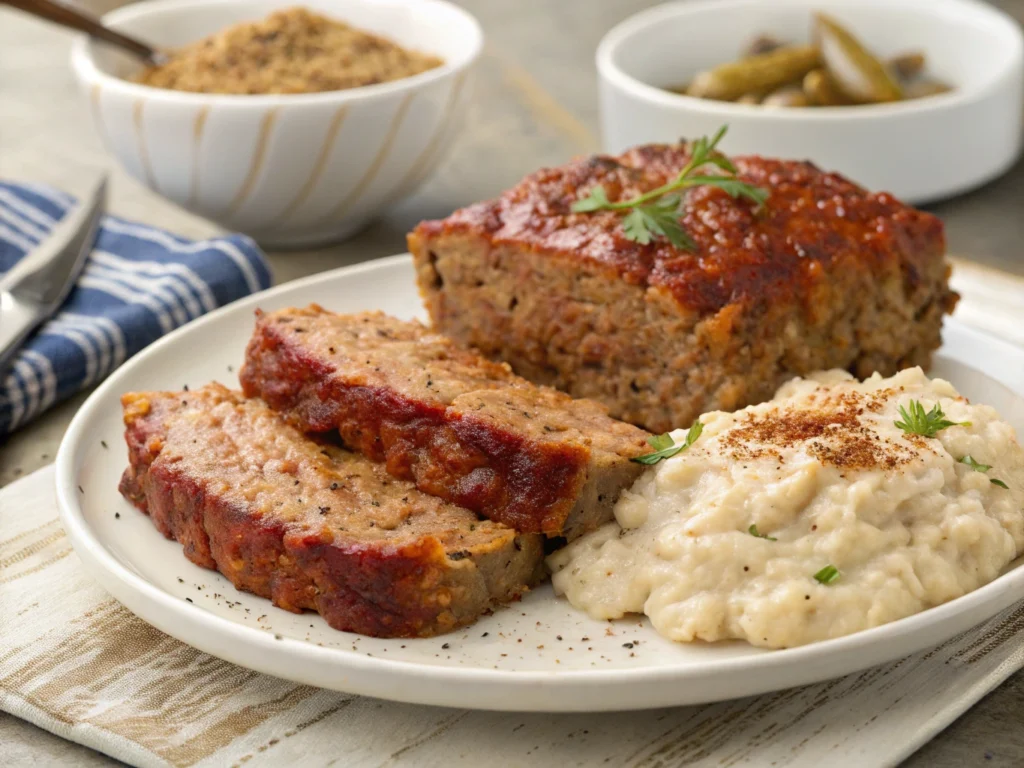
Why Oatmeal Makes the Perfect Meatloaf Ingredient
You might wonder why someone would swap traditional breadcrumbs for oatmeal in a classic recipe. The answer lies in both science and sensory experience.
The Science Behind Using Oatmeal Instead of Breadcrumbs
Oatmeal possesses a remarkable ability to absorb and retain moisture during cooking—significantly more effectively than breadcrumbs. This moisture-binding superpower creates a finished meatloaf that remains tender and juicy even when reheated as leftovers.
The structure of oats contains soluble fiber that forms a gel-like substance when combined with liquid ingredients. This natural gelation helps bind your meatloaf while keeping it moist. In contrast, breadcrumbs often absorb moisture initially but can release it during cooking, sometimes resulting in a drier final product.
When choosing which oatmeal variety works best:
- Quick oats blend almost seamlessly into your mixture
- Old-fashioned rolled oats provide slightly more texture
- Steel-cut oats aren’t recommended (they remain too firm)
- Always use plain, unflavored varieties
A nutritional comparison reveals oatmeal’s advantages over typical breadcrumbs:
| Nutrient (per 1/2 cup) | Plain Oatmeal | Plain Breadcrumbs |
|---|---|---|
| Fiber | 4g | 2g |
| Protein | 5g | 4g |
| Sodium | 0mg | 250+mg |
| Added Sugar | 0g | Often present |
Health Benefits of Adding Oatmeal to Your Meatloaf
Incorporating oatmeal into your meatloaf creates a comfort food classic with surprising nutritional benefits:
- Increased dietary fiber: Each serving delivers approximately 3-4 grams of fiber, supporting digestive health and creating greater satiety
- Reduced overall fat content: Oatmeal’s absorbent nature allows you to use slightly leaner meats without sacrificing moisture
- Whole grain goodness: Unlike refined breadcrumbs, oatmeal provides whole grain benefits, including B vitamins and minerals
- Potential cholesterol benefits: Beta-glucan, the soluble fiber in oats, has been shown to help manage blood cholesterol levels
- Extended protein utilization: The combination of animal protein with complementary plant protein supports muscle maintenance
The American Heart Association and numerous nutritional studies highlight oats as a heart-healthy food. By incorporating them into comfort foods like meatloaf, you bridge the gap between nutritional wisdom and culinary tradition.
Essential Ingredients for the Perfect Meatloaf with Oatmeal
Creating truly memorable meatloaf begins with selecting quality ingredients and understanding how they work together.
Meat Selection: Finding the Right Balance
The foundation of exceptional meatloaf starts with thoughtful meat selection:
For traditional flavor with ideal texture, consider these combinations:
- 80% lean ground beef (provides necessary fat for flavor)
- 50/50 blend of ground beef and pork (adds complexity)
- Classic “meatloaf mix” (equal parts beef, pork, and veal for tender results)
Fat percentage matters significantly. While modern health consciousness might push you toward the leanest options, extremely lean meat (90%+) often produces dry meatloaf. Aim for 80-85% lean for the perfect balance of flavor and health considerations.
If budget constraints affect your choices, remember that proper technique can elevate even basic ground beef. Properly hydrated oatmeal helps maximize moisture retention in more economical cuts.
The Supporting Cast: Vegetables, Seasonings, and Binders
While meat forms the foundation, these supporting ingredients create a truly memorable meatloaf:
Aromatic Vegetables:
- Finely diced onion (1 medium) provides sweetness and moisture
- Minced garlic (2-3 cloves) contributes essential aromatic depth
- Finely diced celery (1-2 stalks) adds subtle texture and vegetable flavor
- Grated carrot (1 medium) incorporates vegetables invisibly while adding moisture
Flavor Builders:
- Worcestershire sauce (2 tablespoons) delivers complex umami notes
- Dijon mustard (1 tablespoon) provides subtle acidity and depth
- Tomato paste (2 tablespoons) enhances meaty flavors while adding binding properties
- Fresh herbs (parsley, thyme) offer brightness that balances richness
For optimal binding, use 2 large eggs and about ¾ cup oatmeal per 2 pounds of meat mixture. This ratio creates proper cohesion without resulting in a dense texture.
The 5-Step Meatloaf with Oatmeal Recipe: Simplified Process
Creating perfect meatloaf doesn’t require culinary school training—just attention to a few key techniques.
Step 1: Preparing Your Ingredients
Begin by gathering everything you’ll need:
- 2 pounds ground meat (your chosen blend)
- ¾ cup quick or old-fashioned oats
- 1 medium onion, finely diced
- 2-3 garlic cloves, minced
- 1 medium carrot, grated
- 1-2 celery stalks, finely diced
- 2 large eggs, lightly beaten
- 2 tablespoons Worcestershire sauce
- 1 tablespoon Dijon mustard
- 2 tablespoons tomato paste
- 1 teaspoon salt
- ½ teaspoon black pepper
- 3 tablespoons fresh parsley, chopped
- 1 teaspoon dried thyme (or 1 tablespoon fresh)
For best results, dice vegetables consistently—about ¼-inch pieces ensure they’ll cook through while maintaining some texture. Consider briefly soaking your oatmeal in 2-3 tablespoons of milk or broth before adding to the mixture for enhanced moisture.
Equipment needed includes a large mixing bowl, measuring spoons, cutting board, sharp knife, and either a loaf pan or baking sheet.
Step 2: The Perfect Mixing Technique
The difference between perfectly textured meatloaf and tough, dense disappointment often comes down to mixing technique. Professional chefs emphasize this crucial point: mix just until ingredients are combined—no more.
Follow these steps:
- Place your ground meat in a large bowl
- Add pre-soaked oatmeal and beaten eggs
- Sprinkle other ingredients evenly across the surface
- With clean hands, use a gentle “claw” shape to mix
- Lift and fold rather than squeeze or compress
- Stop mixing the moment ingredients appear evenly distributed
You’ll know your mixture is properly combined when you no longer see streaks of separate ingredients, but before the mixture becomes pasty or sticky.
For ideal temperature management, allow refrigerated ingredients to sit at room temperature for 15-20 minutes before mixing. Cold ingredients require more mixing to combine, which can lead to overworking.
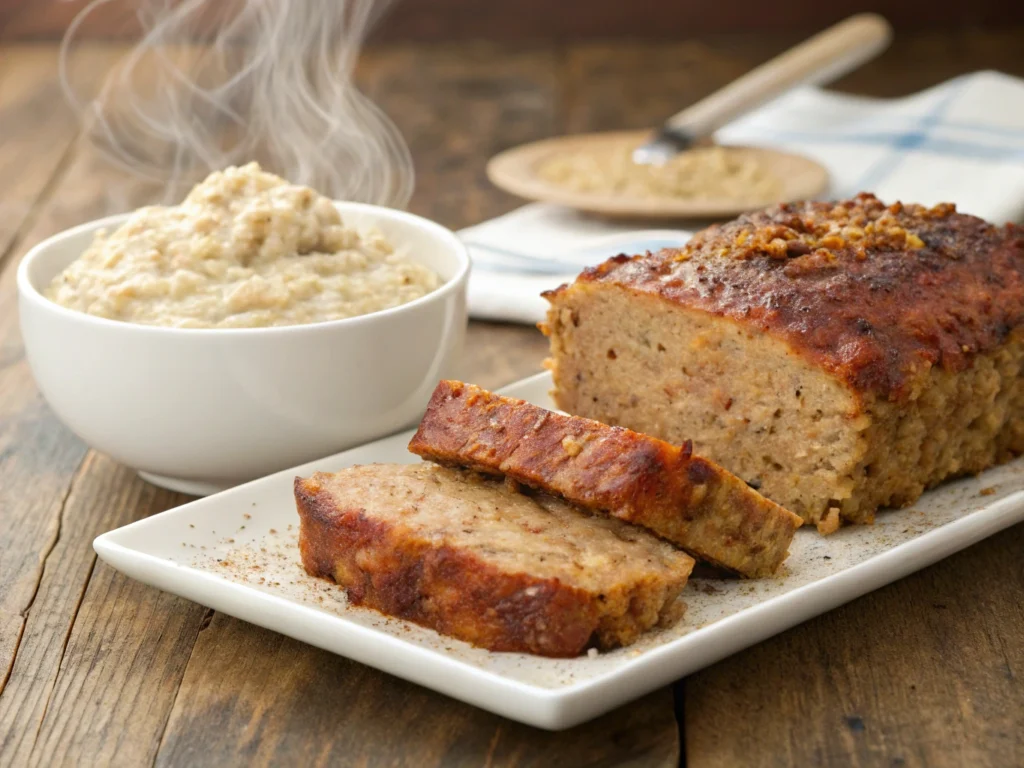
Step 3: Shaping and Preparing for Baking
Your mixing technique creates the foundation, but shaping affects how your meatloaf cooks.
Loaf Pan vs. Free-Form: Both approaches have merit. A loaf pan creates a classic shape and keeps juices contained around the meat. Free-form loaves (shaped on a baking sheet) develop more exterior crust with enhanced flavor. For beginners, loaf pans provide more reliable results.
For perfect free-form shaping:
- Line a baking sheet with foil or parchment
- Transfer meat mixture to the center
- Gently form into a loaf approximately 9×5 inches
- Smooth the top and edges without compressing
- Create a slight indentation along the top for glaze to collect
To prevent the common meatloaf crack, avoid overcompacting your mixture and consider placing a pan of water on the lower oven rack to create humidity during baking.
Individual mini meatloaves offer faster cooking options for weeknights—simply shape into portions about 3 inches in diameter and reduce cooking time to approximately 25-30 minutes.
Step 4: Glazing Options for Delicious Results
A great glaze transforms good meatloaf into spectacular meatloaf. Consider these options based on your flavor preferences:
| Glaze Type | Key Ingredients | Flavor Profile | Best For |
|---|---|---|---|
| Classic | ½ cup ketchup, 2 Tbsp brown sugar, 1 Tbsp cider vinegar | Sweet & Tangy | Traditional meatloaf lovers |
| Savory | ¼ cup beef broth, 2 Tbsp Worcestershire, 1 Tbsp mustard | Rich & Complex | Adult palates |
| Spicy | ⅓ cup ketchup, 1 Tbsp sriracha, 1 Tbsp honey | Sweet Heat | Adventure seekers |
| BBQ | ½ cup barbecue sauce, 1 tsp liquid smoke | Smoky & Sweet | Outdoor cooking fans |
| Maple-Dijon | 3 Tbsp maple syrup, 2 Tbsp Dijon, ½ tsp thyme | Sweet & Sophisticated | Gourmet dinners |
For optimal results, apply your chosen glaze in two stages:
- Brush a thin layer on before baking (after about 30 minutes of cooking)
- Apply a second, more generous layer during the final 15 minutes
This two-stage approach allows the first layer to create a base that helps the final layer adhere beautifully while developing complex flavor during cooking.
Step 5: Baking and Resting for Optimal Results
Perfect baking requires attention to temperature, timing, and technique:
- Preheat your oven to 350°F (175°C)
- Position rack in the middle of the oven
- Bake a 2-pound meatloaf for approximately 55-65 minutes
- Apply final glaze when internal temperature reaches about 145°F
- Remove when internal temperature reaches 160°F (71°C)
- Allow to rest 10-15 minutes before slicing
The resting period might test your patience, but it’s crucial for keeping your meatloaf moist. During this time, residual heat continues cooking while proteins set and juices redistribute throughout the loaf.
Without a thermometer, look for these visual cues of doneness:
- Meatloaf pulls slightly away from pan edges
- Glaze appears set rather than wet
- No pink juices when testing with a knife
- Loaf feels firm but slightly springy when pressed
Keep in mind that adding vegetables to your mixture might extend cooking time slightly due to their moisture content.
Make-Ahead and Storage Tips for Meatloaf with Oatmeal
One of meatloaf’s greatest virtues is its adaptability to busy schedules through make-ahead options.
Freezing Instructions: Before and After Cooking
Meatloaf with oatmeal freezes beautifully, giving you flexible preparation options:
Freezing Raw Meatloaf:
- Prepare mixture and shape as desired
- Wrap tightly in plastic wrap, then foil
- Label with date and freeze up to 3 months
- Thaw completely in refrigerator before baking
- Add 10-15 minutes to standard cooking time
Freezing Cooked Meatloaf:
- Cool completely (within 2 hours of cooking)
- Slice if desired for individual portions
- Wrap tightly, eliminating air contact
- Freeze up to 3 months
- Thaw overnight in refrigerator before reheating
The oatmeal in your recipe actually improves freezer performance—its moisture-retaining properties help prevent freezer burn and texture degradation better than breadcrumb versions.
For perfect portion control, consider freezing individual slices on a parchment-lined tray until solid, then transferring to freezer bags—this allows you to take out only what you need.
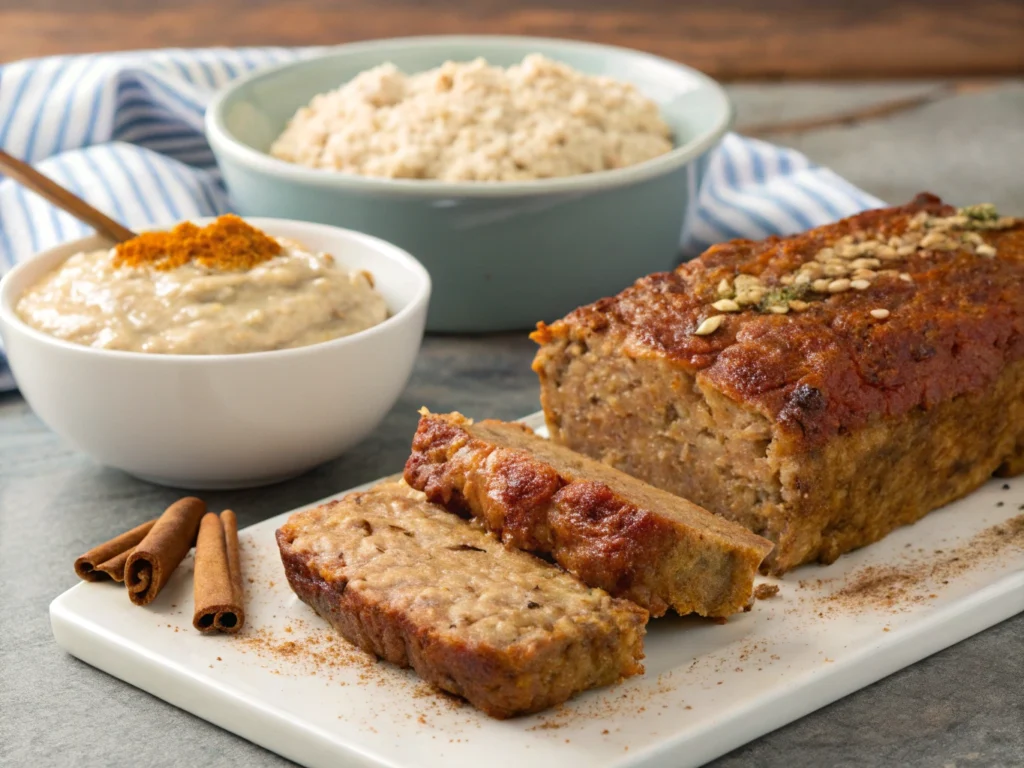
Creative Ways to Repurpose Leftover Meatloaf
Transform yesterday’s dinner into exciting new meals with these approaches:
Meatloaf Sandwich Extraordinaire: Layer cold or warmed meatloaf slices on artisan bread with crisp lettuce, ripe tomato, and a spread of 2 parts mayonnaise mixed with 1 part whole grain mustard.
Meatloaf Pasta Sauce: Crumble leftover meatloaf into a simmering marinara sauce, add extra herbs, and serve over pasta for a quick ragù-style dinner.
Morning Meatloaf Hash: Dice cold meatloaf and crisp in a skillet with parboiled potatoes, bell peppers, and onions. Top with a fried egg for a hearty breakfast.
Meatloaf “Croutons”: Cut leftover meatloaf into small cubes, toss lightly with oil, and crisp in a hot oven for 10 minutes. Add to soups or salads for savory protein bites.
When reheating larger portions, add a tablespoon of broth or water before covering to create steam that refreshes moisture levels.
Variations on the Classic Meatloaf with Oatmeal Recipe
Once you’ve mastered the basic technique, experiment with these creative variations.
Global Flavor Inspirations
Mediterranean Meatloaf with Oatmeal
Transport your table to the Mediterranean with these flavorful additions:
- ⅓ cup chopped sun-dried tomatoes (oil-packed, drained)
- ¼ cup kalamata olives, pitted and chopped
- ½ cup crumbled feta cheese
- 2 teaspoons dried oregano
- 1 tablespoon fresh basil, chopped
- 2 teaspoons lemon zest
Replace the traditional glaze with a mixture of 3 tablespoons tomato paste, 2 tablespoons olive oil, and 1 teaspoon honey. Serve with roasted lemon potatoes and a simple Greek salad for a cohesive meal experience.
This variation pairs beautifully with a medium-bodied red wine like Sangiovese or a crisp white like Assyrtiko.
Asian-Inspired Meatloaf with Oatmeal
Create an unexpected flavor profile with these Eastern influences:
- 2 tablespoons grated fresh ginger
- 3 cloves minced garlic
- 4 green onions, finely chopped
- 2 tablespoons soy sauce (replacing Worcestershire)
- 1 tablespoon sesame oil
- 1 tablespoon rice vinegar
For the glaze, combine equal parts hoisin sauce and ketchup with a dash of five-spice powder. Serve alongside steamed rice and quick-pickled vegetables for a fusion meal that balances tradition and innovation.
Consider garnishing with toasted sesame seeds and additional sliced green onions just before serving.
Dietary Adaptation Options
Gluten-Free Considerations
For those with gluten sensitivities, meatloaf with oatmeal can be easily adapted:
- Use certified gluten-free oats (processed in facilities that prevent cross-contamination)
- Verify all condiments (Worcestershire sauce, mustard, etc.) are gluten-free varieties
- Consider adding ¼ teaspoon xanthan gum if you notice binding issues
- Use gluten-free tamari instead of traditional soy sauce in Asian variations
Remember to maintain separate cutting boards and utensils if preparing for someone with celiac disease to prevent cross-contamination.
Lower-Fat and Heart-Healthy Versions
Enhance the already-healthy aspects of oatmeal meatloaf with these modifications:
- Select 90% lean ground turkey or chicken
- Increase oatmeal proportion to 1 cup per 2 pounds meat
- Add ½ cup grated zucchini for moisture without fat
- Use egg whites (2) instead of whole eggs
- Incorporate ¼ cup finely chopped mushrooms for umami without additional sodium
- Replace salt with salt-free herb blends and a small amount of miso paste
These adjustments create a heart-conscious meal that doesn’t sacrifice the comfort food experience—particularly important if you’re cooking for someone with cardiac health considerations.
Perfect Side Dishes to Complement Your Meatloaf with Oatmeal
A thoughtfully selected side dish elevates meatloaf from simple fare to complete dining experience.
Traditional Pairings with Modern Twists
Reinvent classic accompaniments with these contemporary approaches:
Mashed Potato Variations:
- Roasted garlic and herb mashed potatoes
- Cauliflower-potato mash (half of each for reduced carbohydrates)
- Yukon gold and parsnip blend for subtle sweetness
- Buttermilk and chive mashed red potatoes with skins intact
Vegetable Medleys: Create a sheet pan roasted vegetable assortment that cooks alongside your meatloaf at the same temperature. Toss 3 cups of chopped vegetables (carrots, Brussels sprouts, sweet potatoes) with 2 tablespoons olive oil, salt, pepper, and herbs, then roast for 25-30 minutes while your meatloaf bakes.
For complete nutritional balance, include green vegetables like steamed broccoli, sautéed green beans, or a simple side salad dressed with vinaigrette.
Unexpected Sides that Create a Memorable Meal
Break from tradition with these remarkable pairings:
Global-Inspired Grains:
- Lemon-herb quinoa pilaf
- Wild rice with toasted pecans and dried cranberries
- Farro with roasted mushrooms and thyme
- Pearl couscous with roasted vegetables
Contrasting Texture Salads: A crisp, bright salad provides textural counterpoint to tender meatloaf. Try combining thinly sliced fennel, orange segments, and arugula with a simple citrus vinaigrette.
For wine enthusiasts, consider medium-bodied reds like Merlot or Chianti with traditional meatloaf, while Pinot Noir pairs beautifully with lighter variations.
Troubleshooting Your Meatloaf with Oatmeal Recipe
Even experienced cooks occasionally encounter challenges—here’s how to address common issues:
Common Problems and Their Solutions
| Issue | Potential Causes | Simple Solutions |
|---|---|---|
| Dry Meatloaf | Too lean meat, overbaking, incorrect oat ratio | Add grated vegetables for moisture, reduce cooking time by 5-10 minutes, adjust to ¾ cup oats per 2 lbs meat |
| Mushy Texture | Overmixing, excess liquid, incorrect oat type | Mix minimally, properly drain/cook vegetables before adding, use quick or old-fashioned oats |
| Falls Apart | Insufficient binding, premature cutting, wrong meat ratio | Add an extra egg, allow 15-minute rest before slicing, ensure 80-85% lean meat |
| Lacks Flavor | Underseasoning, old dried herbs, missing umami elements | Season more aggressively (meat mixtures need extra), use fresh herbs, add Worcestershire or tomato paste |
| Uneven Cooking | Irregular shaping, oven hot spots, improper pan | Shape to even thickness, rotate during cooking, use proper loaf pan size |
To prevent these issues before they occur, consider testing a small portion of your mixture: form a mini patty and cook it in a skillet for a few minutes per side. This allows you to adjust seasonings and moisture levels before committing your entire meatloaf to the oven.
Expert Tips for Meatloaf Success Every Time
Professional cooking instructors share these insights for foolproof results:
- Temperature matters: allow ingredients to come to room temperature before mixing
- The “clean hands” method: wet your hands with cold water before mixing and shaping to prevent sticking
- The “light touch” principle: handle the mixture as little as possible for tender results
- Trust your senses: look for visual cues of doneness beyond just timing
- Rest properly: patience during the resting phase rewards you with perfect slices
Remember that cooking is both science and art—measurements provide guidelines, but your preferences should guide final adjustments to create your perfect meatloaf with oatmeal.
Conclusion: Why Meatloaf with Oatmeal Deserves a Regular Spot in Your Dinner Rotation
In a world of complicated recipes and exotic ingredients, there’s something profoundly satisfying about returning to a dish as honest and straightforward as meatloaf with oatmeal. This recipe represents the best of home cooking—nutritious, economical, versatile, and deeply comforting.
By incorporating heart-healthy oats into this classic comfort food, you’re not just preparing a meal; you’re creating an experience that nurtures both body and soul. Whether you stick to the traditional preparation or experiment with global flavors, this five-step recipe provides a reliable foundation for countless memorable family dinners.
As my grandmother always said, the most important ingredient in any meatloaf isn’t found on the grocery list—it’s the love and care that goes into its preparation. So preheat your oven, gather your ingredients, and prepare to create not just a meal, but a tradition that your own family might treasure for generations to come.
Why not make this weekend the perfect time to introduce or reintroduce this classic to your table? Your family will thank you, and you might just start a tradition that brings warmth to your kitchen for years to come.
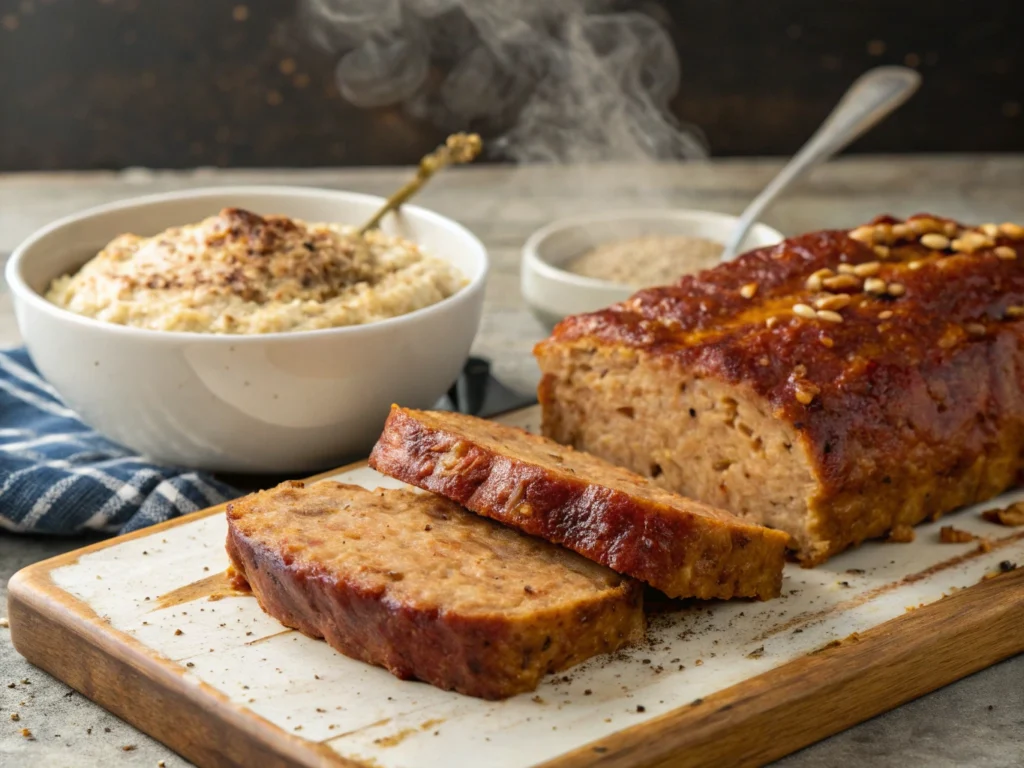
FAQ About Meatloaf with Oatmeal Recipes
Why should I use oatmeal instead of breadcrumbs in my meatloaf?
Oatmeal offers several advantages over traditional breadcrumbs in meatloaf recipes. First, it absorbs and retains moisture more effectively, resulting in a tender, juicy meatloaf that won’t dry out during baking. Nutritionally, oatmeal provides more fiber, protein, and nutrients than most breadcrumbs, making your meatloaf with oatmeal a healthier comfort food option. The texture oatmeal creates is also unique—providing structure while remaining light rather than dense. Additionally, oatmeal is a pantry staple in most households and offers a wonderful gluten-free alternative for those with sensitivities, assuming you use certified gluten-free oats.
What type of oatmeal works best in meatloaf recipes?
Quick-cooking oats generally work best in meatloaf with oatmeal recipes because they integrate seamlessly into the meat mixture and cook perfectly during the standard baking time. Old-fashioned rolled oats are also excellent but may provide a slightly more noticeable texture in the finished dish, which some people prefer. Steel-cut oats are not recommended for meatloaf as they require much longer cooking times and would remain too firm in the finished dish. Instant oatmeal packets should be avoided as they often contain added sugars and flavorings that could clash with your meatloaf seasonings. For best results, use plain, unflavored quick oats or old-fashioned oats depending on your texture preference.
Can I make meatloaf with oatmeal ahead of time?
Absolutely! Meatloaf with oatmeal is an ideal make-ahead dish. You have two excellent options: prepare the meatloaf mixture up to 24 hours before cooking and refrigerate it (uncooked) in your loaf pan, covered with plastic wrap, then simply remove it from the refrigerator 30 minutes before baking. Alternatively, you can fully bake your meatloaf, cool it completely, then refrigerate for up to 3-4 days or freeze for up to 3 months. The oatmeal in the recipe actually helps the meatloaf maintain its moisture and texture during storage and reheating better than many traditional recipes, making it an excellent choice for meal prep or batch cooking for busy weeks.
How do I know when my meatloaf with oatmeal is fully cooked?
The most reliable method for determining doneness in your meatloaf with oatmeal is using an instant-read meat thermometer inserted into the center of the loaf—it should register 160°F (71°C) for beef or pork meatloaf mixtures. Without a thermometer, look for these visual cues: the meatloaf should be browned on top, slightly pulling away from the sides of the pan, and when you insert a knife into the center, the juices should run clear rather than pink. A typical 2-pound meatloaf usually requires about 55-65 minutes at 350°F (175°C), but cooking times can vary based on your oven and the shape/thickness of your particular meatloaf.
Why does my meatloaf with oatmeal sometimes fall apart when slicing?
Several factors can cause a meatloaf with oatmeal to crumble during slicing. The most common mistake is cutting the meatloaf too soon after baking—it needs to rest for at least 10-15 minutes to allow the proteins to set and the juices to redistribute. Other potential causes include insufficient binding (try adding an extra egg next time), inconsistent mixing (ensure ingredients are evenly distributed), or incorrect oatmeal proportion (too much can prevent proper binding). Using meat that’s too lean can also result in a crumbly texture, as a certain amount of fat helps hold everything together. Finally, ensure you’re using the right type of oats—quick or old-fashioned work best, while other varieties may not provide proper binding properties in your meatloaf recipe.
Have you given our recipe a try?
There are no reviews yet. Be the first one to write one.
